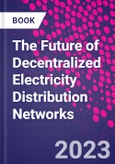The Future of Decentralized Electricity Distribution Networks assesses the evolution of the services delivered by the distribution network as demands placed on it proliferates from distributed, self-generating, power storing and power sharing 'consumers' - which Sioshansi terms 'prosumagers'. The work outlines the processes by which passive and homogeneous electricity consumers become prosumers and prosumagers, the nature of their service needs, and dependence on the services delivered by the distribution network diverges. Contributors assess how consumers are discovering and exercising options to migrate away from total reliance on upstream generators to produce electricity and on the delivery network for its transmission.
As they do so, the "utilities" - be they distributors or retailers - must rethink the traditional utility business model. How will they find sufficient revenues to cover their fixed and variable costs as volumetric consumption declines when some consumers become prosumers - or go a step further and become prosumagers? This work argues that new service, business models and new methods for collecting sufficient revenues to maintain the network are mandatory for the survival of modern utilities.
Please Note: This is an On Demand product, delivery may take up to 11 working days after payment has been received.
Table of Contents
Part One: How technological innovations are changing customers' service needs
1. What drives consumers to become prosumers and prosumagers?
2. Commercial rooftop solar in Australia: State of play, innovations and future prospects
3. Reaching world-record levels of rooftop solar PV: Causes and effects in Queensland
4. Are networks keeping up with what customers need?
Part Two: Old rules, new realities, unsustainable outcome
5. Productive net metering reform: Where do the foundations of regulation, technological change and good economics meet?
6. Leveraging the rise of the prosumer to promote electrification
7. California at crossroads: How not to fumble the opportunities to transform the regulation of the power sector
8. The design and structure of retail electricity markets in Europe
Part Three: Regulation, policy, pricing
9. Telecom pricing: Lessons for emerging electricity networks
10. A new value proposition for electric distribution networks
11. Why fair and efficient network pricing really matters
12. Facilitating power system transformation at the distribution network level
13. In search of a tariff fit for the grid's edge revolution: Reflections from Brazil
14.Performance-based regulation to drive utility transformation and encourage DER markets
15. Re-thinking, re-packaging and re-pricing the grid and retail electricity
Part Four: Case studies, emerging innovative services, new business models
16. How an innovative co-op is planning to thrive amidst the market disruptions: The Case of Holy Cross Energy
17. Turning passive customers into active participants: MCE's innovative DER program
18. How multiple trading relationships could upend historical single supplier business model
19. Innovative products and services to meet the needs of present and future customers
20. The future of grid-interactive efficient buildings and local transactive energy markets








